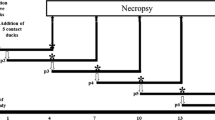Summary
Influenza virus A/turkey/Ontario/7732/66 (H 5 N 9), which is highly pathogenic to chickens, is nonpathogenic to quails. After intratracheal or intramuscular inoculation of quails, virus replication was limited to the respiratory tract, genital organs, and pancreas. However, aggravation of the pathogenicity was achieved through adaptation only by several passages of lung homogenates in quails. The adapted virus caused a fatal generalized infection in quails as well as in chickens. The pathogenic change of the virus could not be explained by a change in the proteolytic cleavability of the hemagglutinin, because no difference was found in the cleavability between the original and the adapted viruses. The adapted virus formed larger plaques and grew a little faster than the original one in both chicken embryo and quail embryo cells. The faster multiplication of the adapted virus at the site of infection might be the reason for its change in pathogenicity.
The original virus could circulate among quails by a direct contact transmission without causing disease. The shed virus, however, caused a fatal infection in chickens when they were kept in contact with the infected quails. The epidemiological significance of this observation is discussed.
Similar content being viewed by others
References
Bosch FX, Garten W, Klenk H-D, Rott R (1981) Proteolytic cleavage of influenza virus hemagglutinin: Primary structure of the connecting peptide between HA1 and HA2 determines proteolytic cleavability and pathogenicity of avian influenza viruses. Virology 113: 725–735
Bosch FX, Orlich M, Klenk H-D, Rott R (1979) The structure of the hemagglutinin, a determinant for the pathogenicity of influenza viruses. Virology 95: 197–207
Easterday BC (1975) Animal influenza. In:Kilbourne ED (ed) Influenza virus and influenza. Academic Press, New York NY, pp 449–481
Garten W, Bosch FX, Linder D, Rott R, Klenk H-D (1981) Proteolytic activation of the influenza virus hemagglutinin: the structure of the cleavage site and the enzymes involved in cleavage. Virology 115: 361–374
Hinshaw VS, Webster RG (1982) The natural history of influenza A virus. In:Beare AS (ed) Basic and applied influenza research. CRC Press, Boca Raton, Florida, pp 79–104
Huang RTC, Rott R, Klenk H-D (1981) Influenza viruses cause hemolysis and fusion of cells. Virology 110: 243–247
Kawaoka Y, Webster R (1985) Evolution of the A/chicken/Pennsylvania/83 (H5N2) influenza virus. Virology 146: 130–137
Kawaoka Y, Naeve CW, Webster RG (1984) Is virulence of H5N2 influenza viruses in chickens associated with loss of carbohydrate from the hemagglutinin? Virology 139: 303–316
Klenk H-D, Garten W, Rott R (1984) Inhibition of proteolytic cleavage of the hemagglutinin of influenza virus by the calcium-specific ionophore A 23187. EMBO J 3: 2911–2915
Reinacher M, Bonin J, Narayan O, Scholtissek C (1983) Pathogenesis of neurovirulent influenza A virus infection in mice. Route of entry of virus into brain determines infection of different populations of cells. Lab Invest 49: 686–692
Rott R (1979) Molecular basis of infectivity and pathogenicity of myxovirus. Arch Virol 59: 285–298
Rott R (1985) Influenzavirus-Infektion bei Mensch und Tier. Berl Münch Tierärztl Wochenschr 98: 340–344
Rott R, Orlich M, Scholtissek C (1982) Differences in the multiplication at elevated temperature of influenza virus recombinants pathogenic and nonpathogenic for chickens. Virology 120: 215–224
Rott R, Reinacher M, Orlich M, Klenk H-D (1980) Cleavability of hemagglutinin determines spread of avian influenza viruses in the chorioallantoic membrane of chicken embryo. Arch Virol 65: 123–133
Scholtissek C, Harms E, Rohde W, Orlich M, Rott R (1976) Correlation between RNA fragments of fowl plague virus and their corresponding gene functions. Virology 74: 332–344
Schulman JL (1983) Virus-determined differences in the pathogenesis of influenza virus infections. In:Palese P, Kingsbury DW (eds) Genetics of influenza viruses. Wien, Austria: Springer, Wien New York, pp 305–320
Slemons R, Easterday BC (1972) Host response differences among five avian species to an influenza virus A/turkey/Ontario/7732/66 (Hav 5 N?), Bull WHO 47: 521–527
Webster RG, Kawaoka Y, Bean WJ (1986) Molecular changes in A/chicken/Pennsylvania/83 (H5N2) influenza virus associated with aquisition of virulence. Virology 149: 165–173
Author information
Authors and Affiliations
Additional information
With 5 Figures
Rights and permissions
About this article
Cite this article
Tashiro, M., Reinacher, M. & Rott, R. Aggravation of pathogenicity of an avian influenza virus by adaptation to quails. Archives of Virology 93, 81–95 (1987). https://doi.org/10.1007/BF01313895
Received:
Accepted:
Issue Date:
DOI: https://doi.org/10.1007/BF01313895




